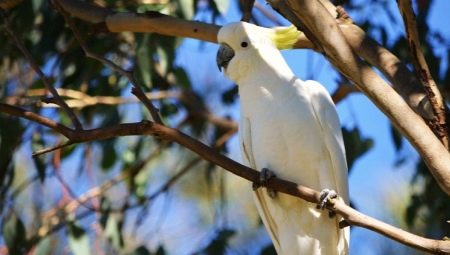Cockatoo parrots are considered one of the most intelligent and extraordinary members of their family. They are incredibly intelligent, active and charming, because of which they often become a beloved and full member of the family. This article will talk about cockatoo parrots: their features, lifestyle and the most famous varieties.
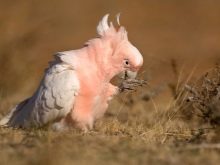
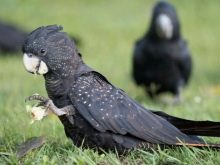
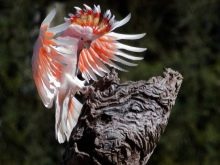
Description
Cockatoo is a bird that belongs to the parrot family. It differs from other representatives of its family by its pronounced intellect, active and extraordinary character, as well as an incredible length of life - up to 100 years.
The most striking difference from other varieties is the presence of a crest or crown (elongated feathers on the individual's head). Raised feathers can simultaneously indicate fear, surprise, anger and joy, depending on the situation. In addition to its “crown”, cockatoos also have other distinctive features.
For example, color - it can be lemon, crimson, orange, pink and even black shades. However, blue or salad shades, popular among other representatives of the family, are not found here.

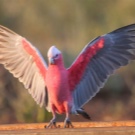
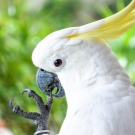
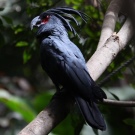
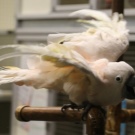
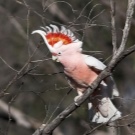
In addition to bright and amazing coloring, Cockatoos are known for their massive, sturdy and downward curved beaks. If in other varieties the beak is purely decorative in nature or serves for eating, then in cockatoo it is a universal helper for grinding nuts, fruits, seeds. Not to mention the fact that they actively use the beak to move around trees and shrubs, as well as when protecting from predators.
The body length of an individual cockatoo individual, depending on the species, can vary from 35 to 85 cm, the average weight of individuals - from 280 grams to 1.1 kg.Species differ in coloring, habitat and diet. Despite external and behavioral differences, all cockatoos are deeply social birds that often become favorites in the family and best friends.

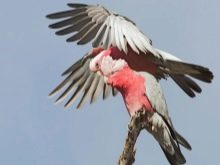
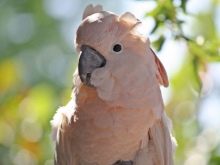
Kinds
Today, there are about 25 varieties of cockatoo. Some of them are not easy to meet even in captivity, and therefore the most common breeds will be listed below. In total, the cockatoo family includes 21 full appearance and 5 genera.
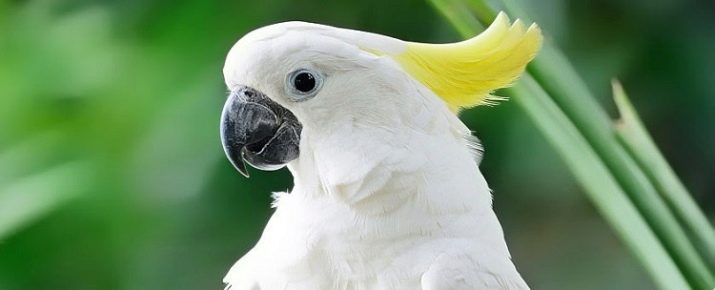
Large and small yellow-crested
This type of cockatoo is characterized by the following features: the head and crest are white, the outer part of the wings is also white. The feathers themselves are narrow and long, the lower part of the plumage is usually yellowish or lemon. The rim near the eyes is naked, not covered with feathers. The difference between the male and the female is in the color of the iris of the eye: if the male’s iris is usually brown or dark brown, then the female’s iris has bright reddish tones. The legs of a yellow-crested parrot are gray, leathery, often gray or black. The beak is also dark, rather short, but massive, the upper part of the beak is bent down.
There are two varieties of a yellow-crested parrot: small and large. They differ from each other by the length of the body and wings, as well as the color of plumage in the crest.
In individuals of a large type of plumage, pale lemon, in individuals of a small - bright yellow, even orange.
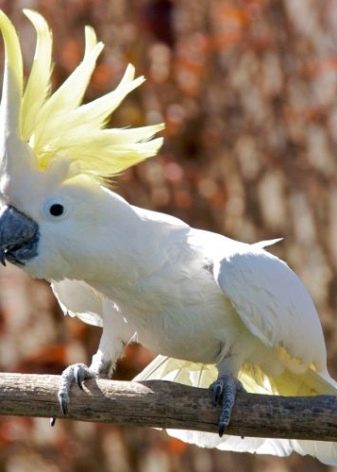
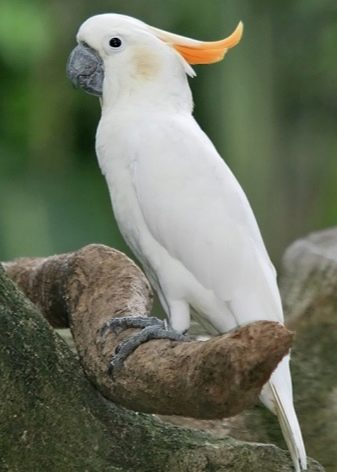
This variety is considered the most popular among bred at home. It is distinguished by its sociability, long lifespan, activity, rapid development of new conditions of detention. However, the bird requires more attention to its personal space. Due to the large size of large species (up to 55 centimeters in length), it is necessary to provide this breed of cockatoos with a cage with a size of at least 100 per 100 cm and a height of at least 170 cm.
Under natural conditions, the bird lives in Australia and Tasmania, moves in packs of up to 30 individuals, the main part of its food is fruits, seeds, insects. She does not have particular preferences, and therefore feels great at home. Good for training. Feeding an adult is twice a day - early in the morning and in the evening. Refers to the type of parrots that can be taught to talk.
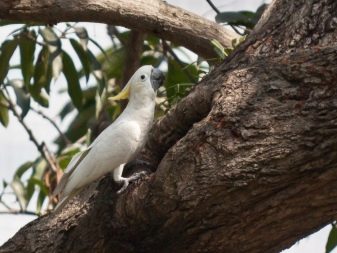

White-headed Cockatoo or Alba
Also a fairly common variety, which can often be found at home. You can recognize it by the snow-white plumage and the crest, which in a raised state forms a characteristic crown. The outer part of some wings may be yellowish or slightly reddish. The rim of the eyes is blue or gray. The difference between the female and the male is in the color of the iris: the female is brown with red shades, the males have black, dark brown shades. Paws are massive, strong, the color is gray or black, like the color of the beak (also massive, the upper part is bent down).
This variety is not the smallest: the body length of mature individuals can be up to 50 centimeters, the wings are as large - up to 35 cm, the tail - up to 18-20 cm. In addition, the species has a rather large weight - up to 600 grams.
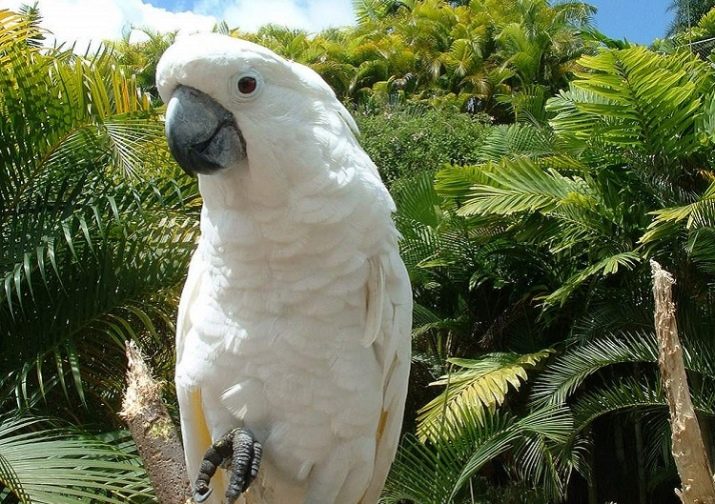
To a greater extent, the species is distributed on the islands of the Moluccan archipelago, found in forests, swamps, mangroves, often forms nests at a height of half a mile above sea level. The diet is similar to the diet of a yellow-crested species: insects, fruits, seeds of fruits and plants. It moves in packs of up to 60 individuals, and in pairs.
At home, the variety is considered extremely sociable, constantly needs communication and attention. She loves to play, fly, in a word - to be naughty. Unlike other species, it has a fairly quiet voice. By nature, calm, playful, trusting and smart.
Also needs a spacious cage and a large variety of toys and performers for entertainment. Refers to the talking kind of cockatoo.
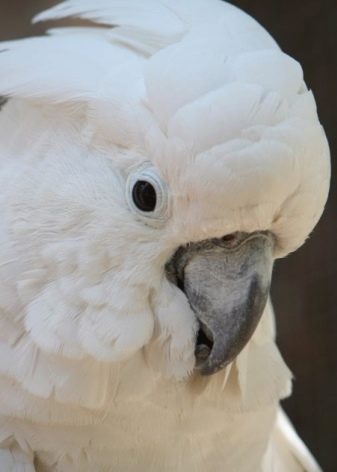
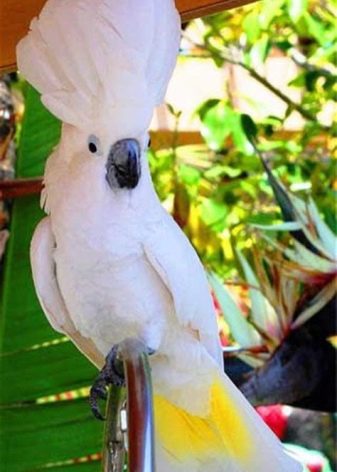
Moluccan Cockatoo
It is considered one of the largest in size among all species of cockatoo. The body length of an adult individual can reach 60 centimeters, while the mass of most individuals often reaches 1.2 kg. A distinctive feature of this species of cockatoo is the white or slightly pinkish plumage, as well as the bright red color of the inside of the comb. Based on the description, it is easy to understand that the bird needs an extremely voluminous cage (up to 2 meters in height) and a huge personal space.
The general description of the species is similar to the description of white-crested and yellow-crested cockatoo: long thin feathers, long crest up to 15 cm long (however, in this case not thin, but wide type), the beak is large, strong, black or gray. Paws are large, massive, gray or dark gray. The iris is dark (male) or burgundy (female) in color, the rim around the eyes without feathers is smooth.
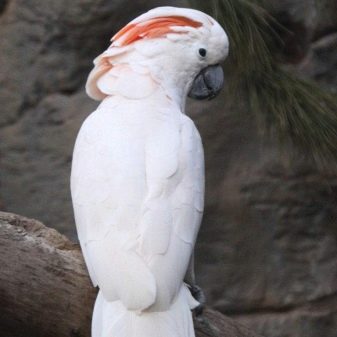

In the natural environment it can live up to 90 years, prefers to move in packs of up to 20 individuals or more. In the diet, prefers insects and seeds. In captivity, he is not particularly picky about food, but it is worth excluding from the diet food that is harmful to parrots (which will be discussed later) and seeds / grains of the Pink family. These cockatoos are large and curious, and instead of breaking an apricot or cherry seed with their beaks, they can simply swallow it.
At home, he is distinguished by activity, friendliness and love for the owner, but also by aggression with poor care and an unfair attitude to himself. The species is prone to depressive disorders, so you should not leave one such parrot.
In case of prolonged absence, it is advisable to leave it in the apartment with the radio or voice mail turned on.
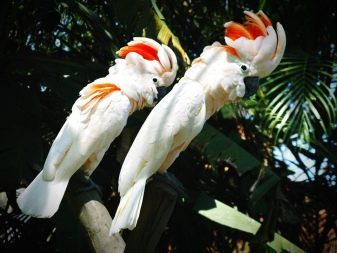
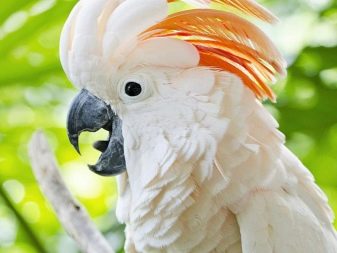
Black or Palm Cockatoo
It is the largest representative of its family - the body length can reach 85 cm (maximum weight - 1000 g). It differs from the rest of the cockatoo in a deep dark color (with a green or reddish tint), a long and bent down beak, and also red or pink wrinkled cheeks, which darken in a state of stress, fear or aggression. Other features: the feathers are quite short and thin, the tail is large and massive, the tuft is long with pointed tips, the eyes are black and brown in color. Males differ from females by the presence of a red tint on the breast and smaller sizes.
The birthplace of the bird is Indonesia, the northern regions of Australia, New Guinea. Unlike other varieties, it prefers to travel more alone or together. Thanks to its strong claws, it perfectly climbs trees, lives and loves to nest at a height, away from the ground. Prefers to eat all the same fruits, seeds and insects during periods of lack of food. In vivo, it is able to live up to 90 years.

When kept at home, it can cause a lot of problems and inconveniences.
- Due to the large wingspan and overall large size, it does not need a cage, but in a real enclosure with a minimum height of 2 meters or more.
- Despite its attractive and exotic appearance, it rarely finds a common language with the owner, often without mood. In a state of aggression, it can pinch and bite the owner.
- Extremely jealous and vindictive - he does not tolerate other pets in the house or especially children. It is not advisable to leave him without a cage in a room with children - he is able to cripple them until the owner has left.
- It does not differ in a colorful voice, with irritation and fear it makes sharp and unpleasant sounds. At the same time, he speaks poorly and almost does not give in to training; in his entire life he can learn no more than 10 words.
Due to the considerable cost, individuals are rarely bred at home. Most often it can be found in contact or private zoos.
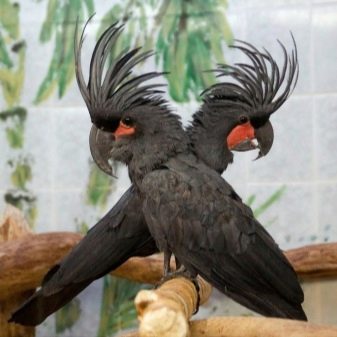

Pink or Cockatoo Gala
One of the smallest known cockatoo varieties. It differs from other birds in the family by extremely small sizes - up to 35 cm, weight is also small - up to 370 grams in the most adult males.The wings are not oblong, rounded, up to 30 cm in length, the tail is also small - up to 12-15 cm. It is practically impossible to distinguish a female from a male until 3 years old, then the iris of the females is significantly lighter and acquires yellowish or even orange shades (the color of the males is still darkens more until dark brown).
The plumage is colorful and colorful, characterized by bright pink, green and red tones. The head is either completely white or light with a pinkish color, the abdomen and body are pink or dark pink, the back is grayish, the wings are usually gray or bluish, the tail is pale green or pale blue. On the head there is a small crest up to 5-7 cm in length, the beak is gray, as well as the claws. It feeds mainly on plants, insects, fruits (papaya, mango, capers).
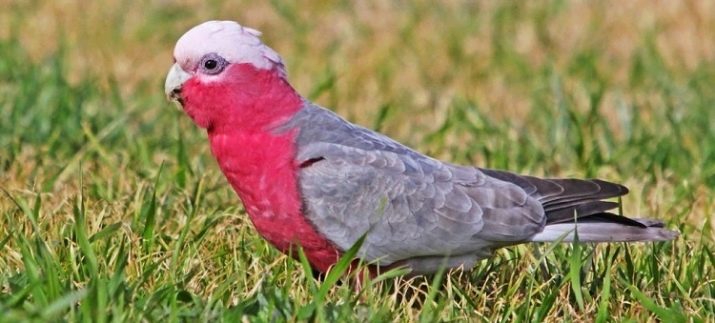
Pros:
- Despite their plain appearance, they live long enough - up to 50-55 years in natural conditions;
- by nature, calm and friendly, quickly get used to the new conditions of detention, become attached to the owner;
- unlike a black or white-winged parrot, it has a quiet and pleasant voice;
- does not need large cages and aviaries, quickly gets used to new food, does not disdain fruits and vegetables.
Minuses:
- they speak rather poorly, although they will try their best to repeat some phrases after you, but in their entire lives they will be able to remember no more than 40 separate words;
- extremely social, without regular communication with the owner can literally wither;
- at home it is considered a real pest - forming flocks of up to 1000 individuals, the species is capable of devastating entire fields.
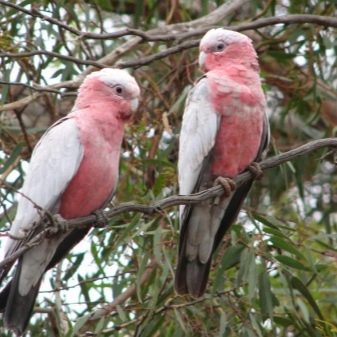
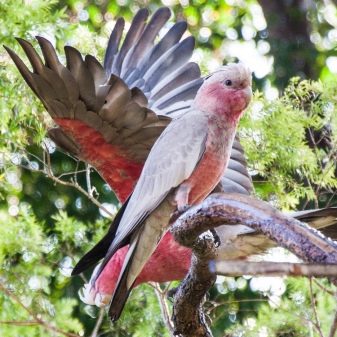
Banks' Mourning, or Blackhead Cockatoo
The rarest and most expensive cockatoo variety among the whole family. It can be recognized by the black plumage covered with golden spots and the red tail. Parrots of this breed are considered long-livers among all cockatoos and are able to live even in captivity for up to 100 years. The species owes its unusual name to the English naturalist Joseph Banks, who lived in the 18th century. The actual habitat of the mourning cockatoo is northern Australia. At the moment, the species has almost disappeared from the face of the Earth, and therefore is under the vigilant protection of the Australian government.
Red-tailed beauties are distinguished by a large total body length (up to 65 cm) and a long tail (up to 28-30 cm). The weight of an individual adult varies around 750 grams. The difference between males and females is quite clear: males (completely black) have red plumage in the tail, females have numerous gold and silver dots and spots throughout the body, and the tail is decorated with dark orange plumage. Moreover, in males, as a rule, the beak is much darker than in females.
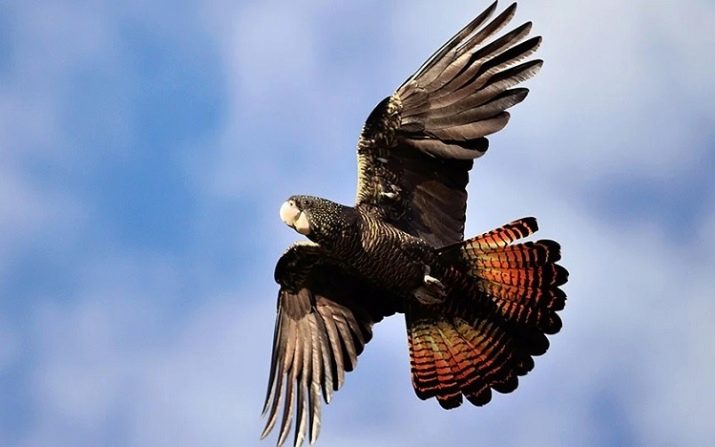
In a natural environment, mourning cockatoos live on the tops of eucalyptus and mangrove trees, where they make nests and hide from the hot Australian sun.
The diet consists of plants, various nuts and seeds, as well as fruits and insects.
The breed is rarely seen in captivity outside of Australia, so it is difficult to assess their intellectual and personal qualities and character traits when living at home. Zoologists claim that they are friendly, gullible, but freedom-loving birds that rarely stay long in one place, preferring to migrate from place to place.
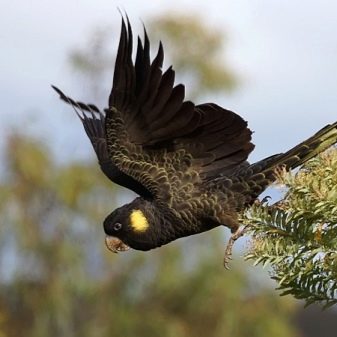

Cockatoo Inca
The variety is rightfully considered one of the most beautiful among the entire family of parrots. It differs from other species in soft pink, sometimes peach plumage and a characteristic mottled tuft. The breed is found exclusively in western Australia, where it lives in mangrove and eucalyptus forests. The species is also resistant to the aridity of the external climate, however, it tries to place nests near water.
It does not differ in large length or weight - up to 40 cm in body length and weight up to 450 grams.The cheeks, head and breast, up to the extremities, are pale pink, the wings are white with a characteristic orange color on the inside. The tail is white, the crest is long and thin - up to 12-15 cm, it contains three shades at once - red, orange and white. The beak is miniature, white, the upper nose is reddish-pink.
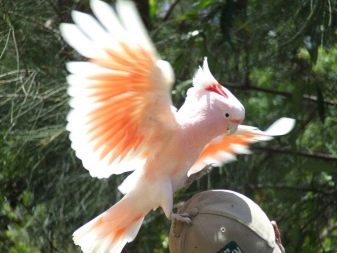
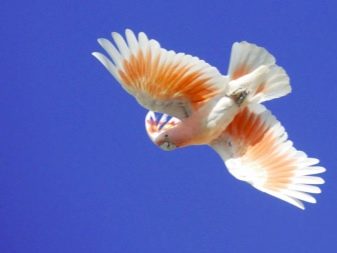
To distinguish a male from a female, again, it is possible only by the eyes. After 3-4 years, in a male, the iris finally darkens, becomes black-brown, in a female acquires red and brownish shades.
In recent years, it has been threatened with destruction due to reduced habitat. This was negatively affected by the end of the twentieth century, when the species was actually considered a pest due to its devastation of crops and fields. At the moment, only the people of Australia can get this cockatoo in private hands, and then with the special permission. Attempts to export from Australia are strictly punishable by law.

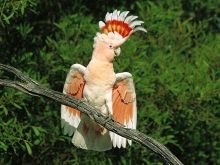
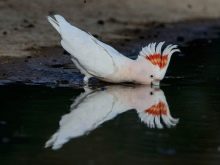
What to feed?
Cockatoo is one of those poultry that require not only very careful care, but also a healthy, balanced and most importantly, a varied diet. In their natural habitat, these birds feed insects larvae, fresh fruit. Such nutrition includes everything you need for the full functioning of the body. That is why at home food should to be not only satisfying, but also contain a large number of trace elements and vitamins.
The main rule in making a cockatoo diet is to find the ideal middle in which the parrot would not experience prolonged hunger, but would not be overfed. Changing the diet with the gradual addition of new products and feed is also one of the important conditions for the proper nutrition of this bird.

The daily feeding of young cockatoo is divided into 3 or 4 stages with the gradual addition of a small amount of food. For adults, 2-3 servings per day will suffice. The nutrition of these birds is based on grain mixtures, seeds, nuts, corn, almonds. At the same time, the food should be as fresh as possible, cockatoos are squeamish to already stagnant food and are more likely to remain hungry than they will try spoiled food.
If you do not have the opportunity to produce high-quality feeding so often and regularly - most likely, this is not your option for a pet.
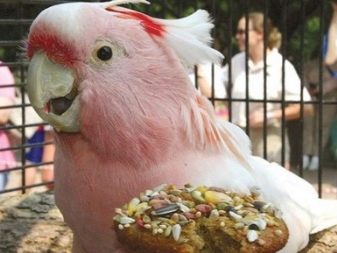
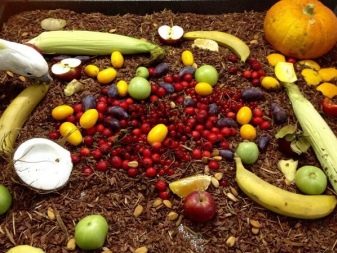
Due to its unique ability to adapt to the external environment, cockatoos are positive about consuming many fruits and vegetables. Of vegetables they love beets, eggplant, cucumbers, carrots, green beans. Parrots can’t do without fruit at all, preferring not only pulp, but also bones, which contain many nutrients for their development. Favorite fruits are pears, apples, pineapples, pomegranates. They also perfectly absorb many berries: cherries and cherries, raspberries, gooseberries, blueberries, strawberries.
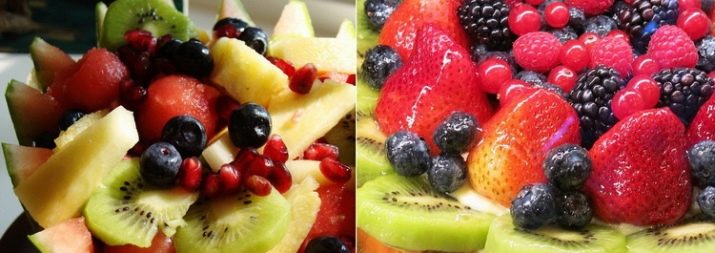
If your bird lacks protein and protein, or is it just a baby gaining strength, you can add some boiled poultry meat or hard cheese to the diet - this is a real treat for cockatoos.
Before serving, the fruit should be cut into slices so that the parrot can safely take them in its paw. Do not leave fruits or other food in the cage for a long time - remove them immediately so that they do not start to deteriorate and the bird does not poison them. Young cockatoos may not eat anything except sunflower seeds for a long time. In this case, try to gradually add more fruits to the diet and reduce the simultaneous supply of seeds.
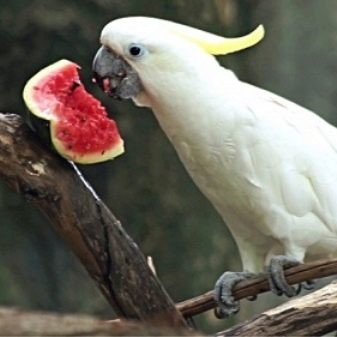
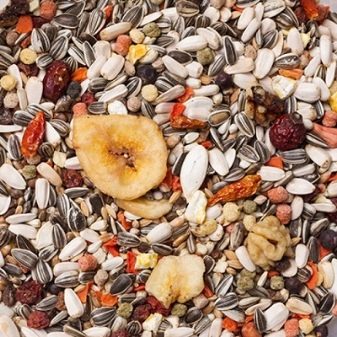
Of course, there are products that should not be given to parrots even in the smallest quantities.
- You should immediately delete from the diet all sweets, as well as foods with a high sugar content. This is especially true for sweets and chocolate products.The fact is that sugar contains substances harmful to parrots that affect their digestion processes.
- Under no circumstances try to give the cockatoo fatty, fried, salted or pickled foods. All these products can be very loved by your bird, but in any case they will negatively affect its body.
- Refuse to add milk to the diet, it contains lactose harmful to parrots, which they cannot physiologically process purely. Because of this, intestinal upsets and diarrhea can occur in birds.
- For large specimens, it is not recommended to give fruits with large kernels - in order to avoid the parrot swallowing whole bones.
- Forget about movies about pirates, and in no case give alcohol to your crested friend as food or drink. Even a minimal dose of alcohol can have a fatal effect on poultry organs.
- Of all the common fruits and vegetables, cockatoos are strictly forbidden to give avocados. This fruit contains a huge percentage of fat, which will not be able to process the body of this bird. It is also not recommended to give parsley, cabbage and coffee.

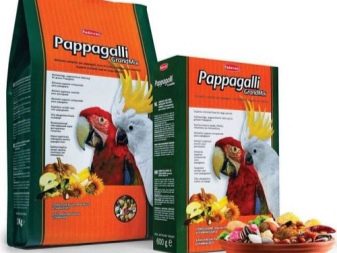
Before adding new fruits, vegetables, grains and other products to the diet consult an experienced zoologist or veterinarian in advance. It will help you not only to eliminate harmful substances from the diet, but also make a detailed diet of the bird in the near future.
Constantly maintain a stable level of water in the cage of a parrot, while it is advisable to give not only freshly collected or filtered water, but also settled water.
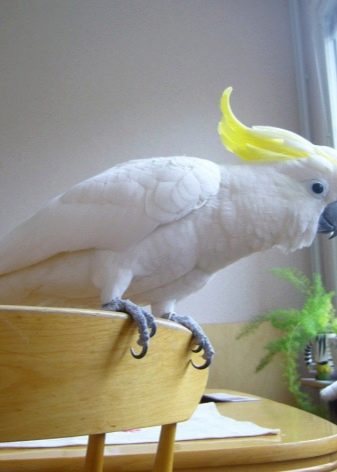

Features of care and maintenance
One of the most important points in breeding cockatoo is the conditions of detention. It is on comfort and how the bird will be looked after, its mood and health depend. At the very beginning, you should think about buying a cell if you want to breed cockatoo at home. A cage is a must for a cockatoo - parrots should have their own place, where they are always waiting for food and drink, entertainment.
Most cockatoo varieties are large birds with a huge wingspan, which is why the approximate characteristics of the cage should be at least 120x90x120 cm. It should be moderately spacious indoor with good oxygen circulation. To make the cage easier to wash and clean of excrement and food, buy an option with a retractable bottom.
If you plan to breed cockatoo and expect to grow several individuals outside the home, then you should take care of buying a large aviary with dimensions of at least 4.5x2x2 meters. In the enclosure, several separate houses for each parrot should be built. Just as in the situation with the cage, fill the aviary with some number of toys, poles and places of rest. In the cage / aviary there must be a small hard thing that the parrot could nibble on.
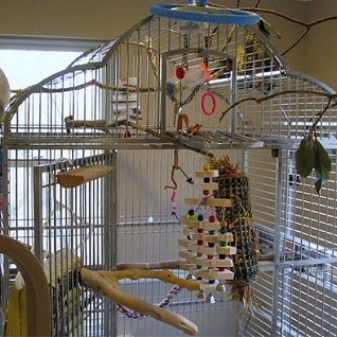
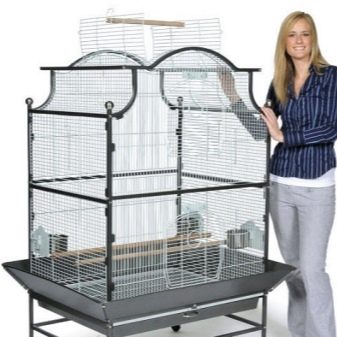
As for the material from which the cell should be, then first of all consider metal cells. During a period of activity and boredom, a cockatoo can simply damage polymer or wooden structures. Feeding troughs, a latch or a lock must also be made of strong and durable material, the lock must be strong and complex, otherwise such an intelligent bird as a cockatoo can simply crack it. Refuse from solid glass cages like aquariums - a cockatoo constantly needs an influx of fresh air, moreover, such aquariums are much more difficult to clean.
The cage should be placed in a well-lit place. with an approximate temperature of 18-20 degrees Celsius. The desired humidity level should not be lower than 70%, drafts should not be allowed. Some breeders prefer to place the bird near the window on the sunny side, however this is acceptable only in winter, when the bird needs as much light and heat as possible. Do not put the bird near the batteries and in direct sunlight, this can also come in handy with serious diseases.
Cockatoo - incredible cleanlings and picks, they do not tolerate dirt and dust, so the cage should be equipped with an impromptu pool in which your parrot could swim.

If there is no place for a pool or it is constantly clogged - once a day you can spray your bird from an ordinary spray bottle, the water should be warm and a little settled.
One of the unpleasant features of the cockatoo is its very high and loud voice. An annoyed, hungry, or simply bored bird can bring a lot of worries to both you and your neighbors. That is why it is better to prepare a room with a tolerant soundproofing for a parrot.
Avoid too frequent contact with the animal. If you teach a cockatoo to constant attention, then when you are not at home, the bird will certainly get bored, which will affect its health. This difficulty applies to a greater extent to families with children, where young children up to some age are actively interested in the bird and play with it, and then they come less and less.
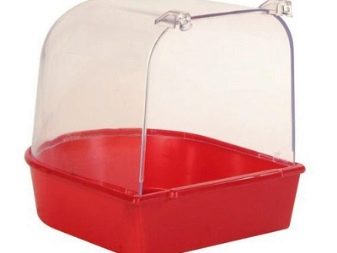
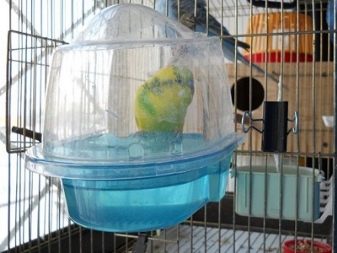
Life expectancy at home
Cockatoos are notable for their phenomenal life expectancy among their brethren - in rare cases in individual individuals it reaches 90 and even 95 years. However, when buying any kind of cockatoo, you should not count on any specific lifespan. This is exactly the case when absolutely everything depends on the owner. Regularity and completeness of feeding, careful care are only the necessary minimum that is required of you.
The biggest drawback, and at the same time, the greatest advantage of this species is its incredible social affection. In the natural environment, until the maturity period is reached, the parrots move in packs until they find the only partner with whom they will remain until their death.
That is why cockatoos, as well as in a love field, are very attached to their owners and tend to miss them during their long absence. If you spend a lot of time at work or traveling - it may happen that your little bird gets bored. And this can lead to serious depression in her. Everything, including separation, can and should teach a bird.
Start with short deadlines - go to another room for a while and leave the parrot alone, then return (you can bring some goodies). Gradually increase the duration of the separation - the cockatoos should get used to the fact that if you leave, you will definitely return.

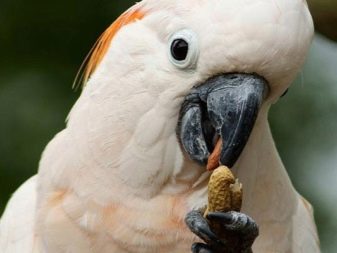
Common diseases
Unfortunately, there are no animals immune to disease and death. Depending on the care, upbringing, living conditions, your bird may get sick. Below are the most common ailments in this species of bird.
- digestive disorders;
- parasitic infections;
- pulling feathers - with stress, boredom and hunger;
- pneumonia, some infectious diseases.
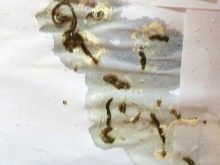
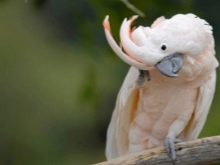
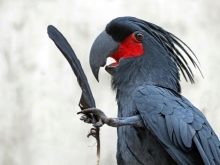
Common Disease Symptoms:
- poor appetite or its complete absence;
- regular and increasing sneezing;
- tearing of the eyes, discharge from the nostrils;
- sharp appearance of prolonged screams;
- looks tired, breathes deeply, eyes are blurred, a little covered.
The main condition for the occurrence of one or more of the symptoms described above is to abandon self-medication and consult a veterinarian as soon as possible. This is not a species of animals that is able to recover from a disease on its own.
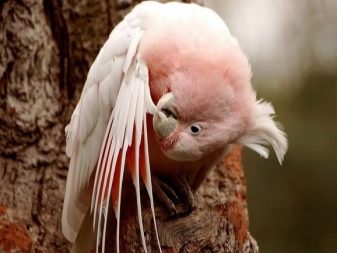
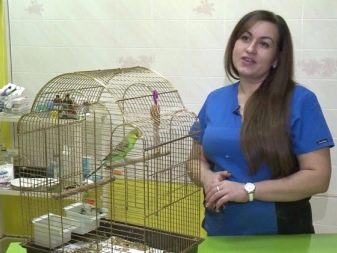
Most often, the following leads to the appearance of diseases and the subsequent death of the bird:
- irregular nutrition, lack of food and water;
- lack of variety in the diet;
- untimely treatment of colds;
- the inclusion of prohibited cockatoo foods in the diet;
- prolonged absence of the owner or social contacts.
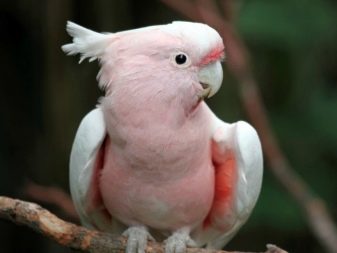
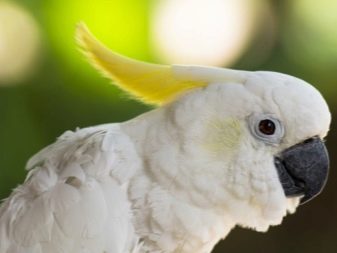
See below for more details.
